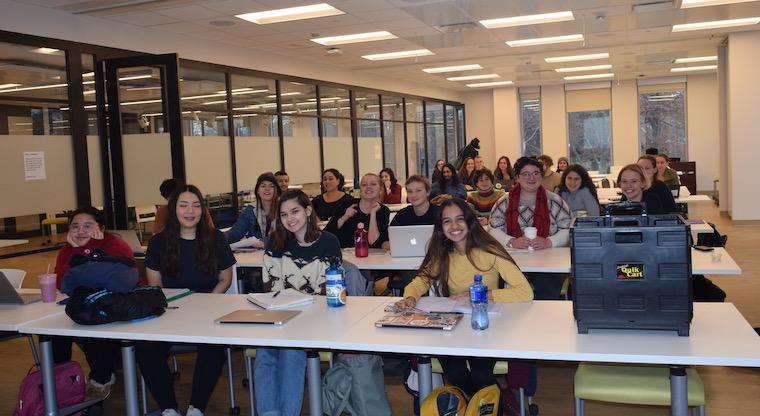Immigration in U.S. History Students Partner with Ohio Immigrant Worker Project
February 4, 2019
Erin Ulrich ’18

Immigration in U.S. History students after turning in their asylum case research for the class.
Photo credit: Courtesy of Shelley Lee
Associate Professor of Comparative American Studies and History and Chair of Comparative American Studies Shelley Lee collaborated with the Ohio Immigrant Worker Project (IWP) this past fall semester through her course, Immigration in U.S. History.
Lee, whose scholarship centers on Asian American history, immigration, and race relations, incorporated an experiential learning component into the course and facilitated hands-on engagement between her students and advocates at the organization. At the IWP, students from Lee’s class worked in pairs on different asylum application cases, producing “evidence packets” supporting the clients’ reasons for fleeing the conditions of their home countries.
Founded in 1999, the IWP was born out of the exponential growth of the Latino population in Ohio at the turn of the 21st-century and the lack of formal support structures available to help immigrants navigate their new lives in rural Ohio.
The IWP’s leadership structure, comprised of 70 percent immigrant workers, materialized through intentional efforts to ensure that the organization’s leadership represents the clients in the community it serves.
The inclusiveness reflected in the organization’s leadership is a critical piece of the IWP’s vision of creating a cohesive image of community and belonging for Latino immigrants living in the region. The IWP’s services span from aiding employers in recruitment processes, offering free computer classes taught in Spanish, as well as a legal clinic with free consultations, a free translation service, and providing basic legal rights to incarcerated detainees.
The course historicizes contemporary debates about immigration and is especially relevant in the current political moment. Immigration has become the nucleus of policy decisions as well as the recent 35-day government shutdown—the longest in U.S. history. Lee says that although current events have always influenced students’ interest in the course, the prevalence of immigration rhetoric in the national discourse especially influenced this year’s class.
“Last fall, things felt especially urgent,” she says. “We brought the present into the class much more than we did in previous semesters.”
Yonce Hitt ’19, who took Lee’s course this fall, was especially drawn to the work the IWP does and decided to create a winter-term project with the organization. Hitt, who is interested in applying to law school after graduating from Oberlin, sat in on asylum seekers’ intakes, filled out I-589s (Application for Asylum and Withholding of Removal forms) for clients, drove clients to an ICE facility in Cleveland for their government check-ins, and advocated on their behalf. This included negotiating arrangements for the electronic monitoring anklets many of them are required to wear.
Hitt says that the emotional demand of the work, including filing accounts of clients fleeing their home countries, served as motivation to work harder.
“It made me more determined to aid in the ways I could,” Hitt says. “This would hopefully prevent the worst case scenario: Deportation back to the area where they experienced these traumas.”
The staff at the IWP, Hitt says, “taught me not only how difficult the work is, but how valuable it is, especially in areas outside of major cities where there are often fewer resources to aid people through this complex process.”
Lee says that she hopes her students’ experiences with the IWP put the reality of challenges immigrants face into perspective.
“The work IWP does is unglamorous and often demoralizing,” she says. “But the organization has made a remarkable difference with individual cases and challenging unjust laws and practices. And they’re still here after 20 years.”
You may also like…
Josh Nolan Named Vice President, General Counsel, and Secretary at Oberlin
Distinguished attorney brings extensive experience in higher education law.
Learning by Teaching: Oberlin Students Share Global Music with Young Learners
College and Conservatory students in PACE 103 prepare local children for an immersive community concert at Oberlin.
Nuiko Wadden ’02 Joins Oberlin Conservatory Faculty as Assistant Professor of Harp
The versatile musician brings extensive opera, orchestral, and contemporary music experience to her role


